FIN201 Assignment: Portfolio Weights, CAPM & Dividend Policy Analysis
VerifiedAdded on 2023/06/12
|10
|1875
|221
Report
AI Summary
This report provides a comprehensive analysis of portfolio weights, Capital Asset Pricing Model (CAPM), and dividend policies, focusing on Commonwealth Bank and BHP Billiton. It calculates optimal portfolio weights for achieving a 12% expected return using different asset combinations and evaluates whether the assets are priced according to the CAPM. The report also examines the dividend policies of both companies, contrasting their dividend payout ratios and evaluating changes in these policies over time. Specifically, it highlights BHP Billiton's dividend policy change in 2016 and assesses the impact of this change on the company's share price performance. The analysis incorporates financial data from 2006 to 2017 to provide a detailed overview of the companies' financial strategies and performance.
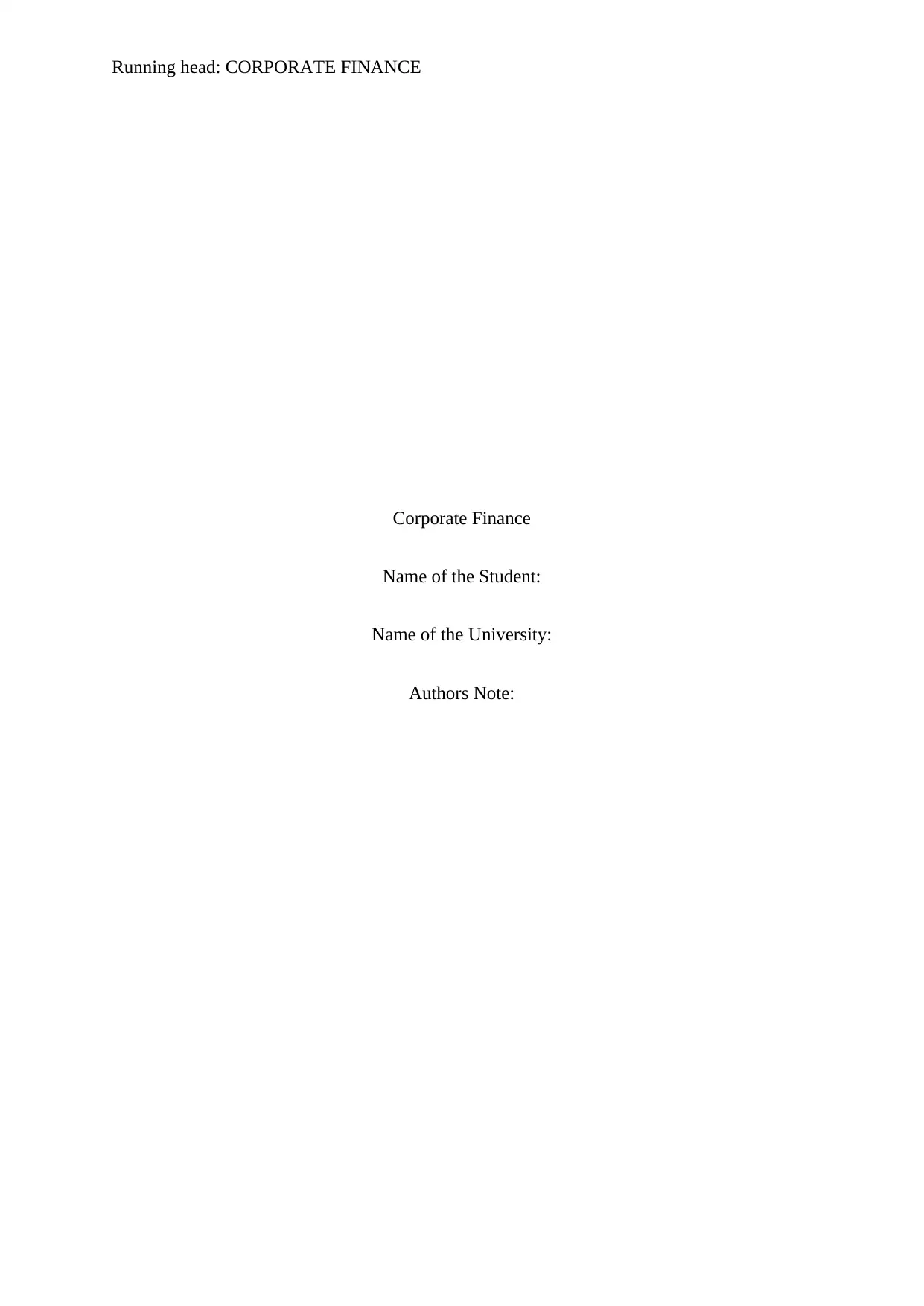
Running head: CORPORATE FINANCE
Corporate Finance
Name of the Student:
Name of the University:
Authors Note:
Corporate Finance
Name of the Student:
Name of the University:
Authors Note:
Paraphrase This Document
Need a fresh take? Get an instant paraphrase of this document with our AI Paraphraser
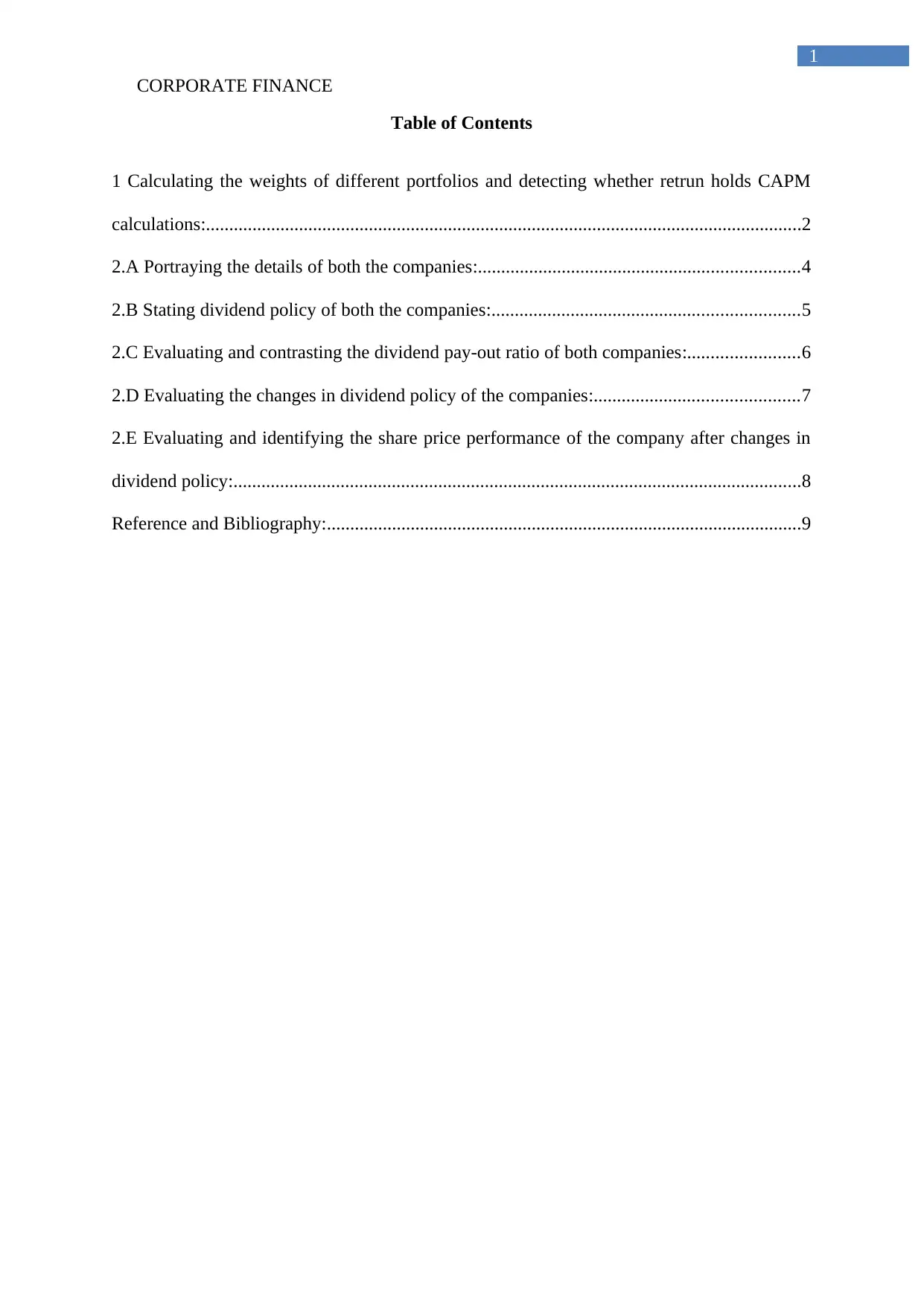
CORPORATE FINANCE
1
Table of Contents
1 Calculating the weights of different portfolios and detecting whether retrun holds CAPM
calculations:................................................................................................................................2
2.A Portraying the details of both the companies:.....................................................................4
2.B Stating dividend policy of both the companies:..................................................................5
2.C Evaluating and contrasting the dividend pay-out ratio of both companies:........................6
2.D Evaluating the changes in dividend policy of the companies:............................................7
2.E Evaluating and identifying the share price performance of the company after changes in
dividend policy:..........................................................................................................................8
Reference and Bibliography:......................................................................................................9
1
Table of Contents
1 Calculating the weights of different portfolios and detecting whether retrun holds CAPM
calculations:................................................................................................................................2
2.A Portraying the details of both the companies:.....................................................................4
2.B Stating dividend policy of both the companies:..................................................................5
2.C Evaluating and contrasting the dividend pay-out ratio of both companies:........................6
2.D Evaluating the changes in dividend policy of the companies:............................................7
2.E Evaluating and identifying the share price performance of the company after changes in
dividend policy:..........................................................................................................................8
Reference and Bibliography:......................................................................................................9
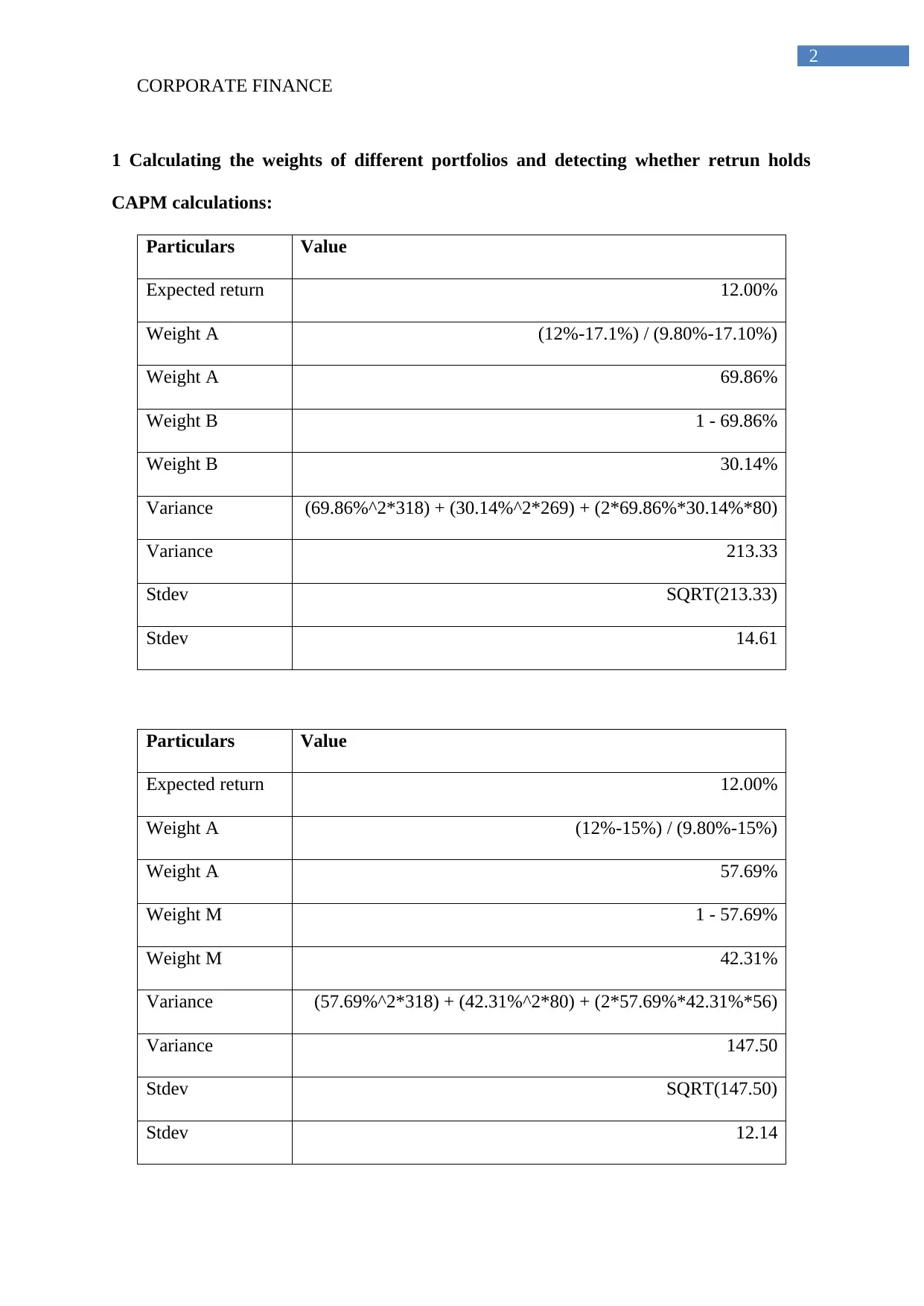
CORPORATE FINANCE
2
1 Calculating the weights of different portfolios and detecting whether retrun holds
CAPM calculations:
Particulars Value
Expected return 12.00%
Weight A (12%-17.1%) / (9.80%-17.10%)
Weight A 69.86%
Weight B 1 - 69.86%
Weight B 30.14%
Variance (69.86%^2*318) + (30.14%^2*269) + (2*69.86%*30.14%*80)
Variance 213.33
Stdev SQRT(213.33)
Stdev 14.61
Particulars Value
Expected return 12.00%
Weight A (12%-15%) / (9.80%-15%)
Weight A 57.69%
Weight M 1 - 57.69%
Weight M 42.31%
Variance (57.69%^2*318) + (42.31%^2*80) + (2*57.69%*42.31%*56)
Variance 147.50
Stdev SQRT(147.50)
Stdev 12.14
2
1 Calculating the weights of different portfolios and detecting whether retrun holds
CAPM calculations:
Particulars Value
Expected return 12.00%
Weight A (12%-17.1%) / (9.80%-17.10%)
Weight A 69.86%
Weight B 1 - 69.86%
Weight B 30.14%
Variance (69.86%^2*318) + (30.14%^2*269) + (2*69.86%*30.14%*80)
Variance 213.33
Stdev SQRT(213.33)
Stdev 14.61
Particulars Value
Expected return 12.00%
Weight A (12%-15%) / (9.80%-15%)
Weight A 57.69%
Weight M 1 - 57.69%
Weight M 42.31%
Variance (57.69%^2*318) + (42.31%^2*80) + (2*57.69%*42.31%*56)
Variance 147.50
Stdev SQRT(147.50)
Stdev 12.14
⊘ This is a preview!⊘
Do you want full access?
Subscribe today to unlock all pages.

Trusted by 1+ million students worldwide
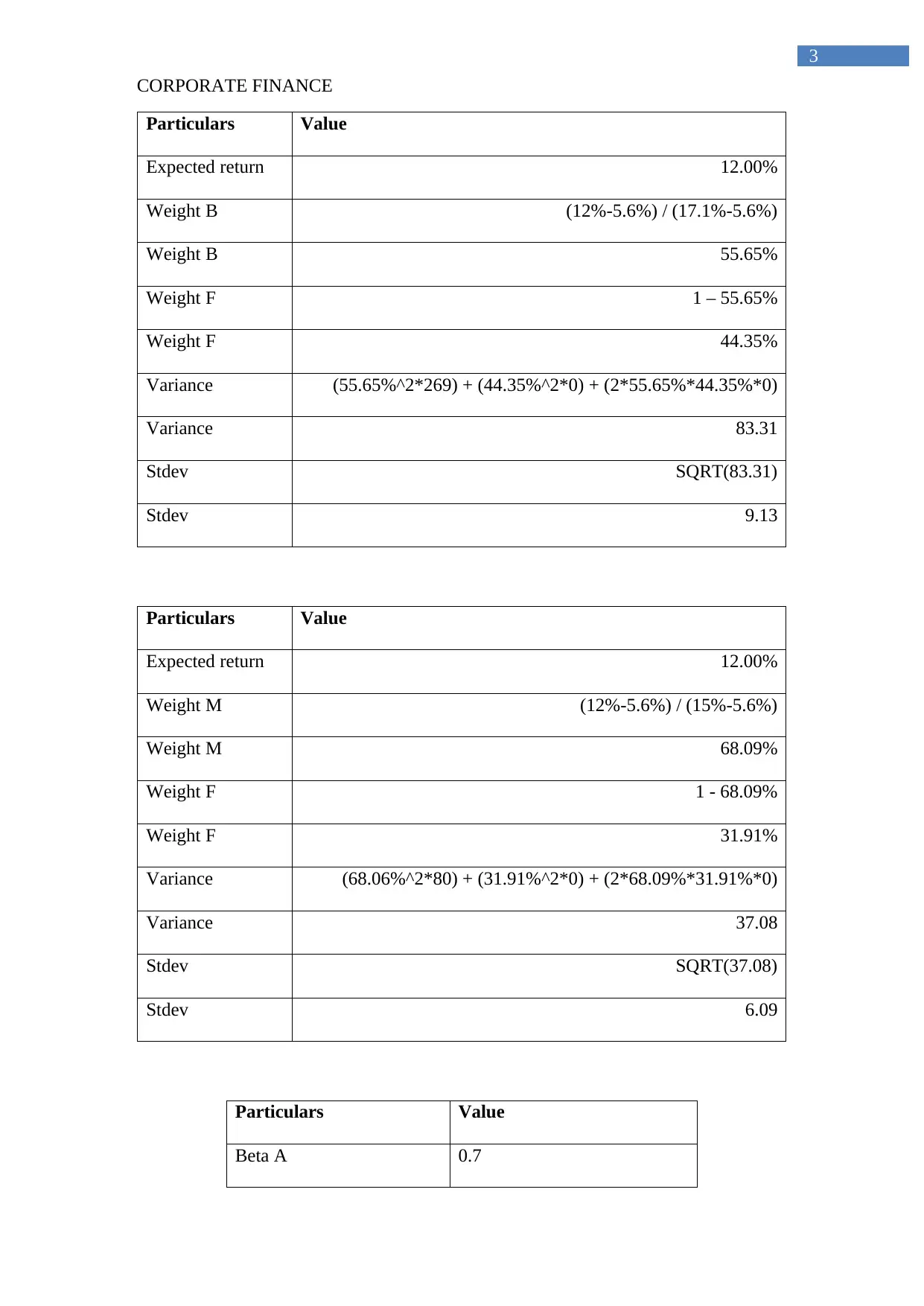
CORPORATE FINANCE
3
Particulars Value
Expected return 12.00%
Weight B (12%-5.6%) / (17.1%-5.6%)
Weight B 55.65%
Weight F 1 – 55.65%
Weight F 44.35%
Variance (55.65%^2*269) + (44.35%^2*0) + (2*55.65%*44.35%*0)
Variance 83.31
Stdev SQRT(83.31)
Stdev 9.13
Particulars Value
Expected return 12.00%
Weight M (12%-5.6%) / (15%-5.6%)
Weight M 68.09%
Weight F 1 - 68.09%
Weight F 31.91%
Variance (68.06%^2*80) + (31.91%^2*0) + (2*68.09%*31.91%*0)
Variance 37.08
Stdev SQRT(37.08)
Stdev 6.09
Particulars Value
Beta A 0.7
3
Particulars Value
Expected return 12.00%
Weight B (12%-5.6%) / (17.1%-5.6%)
Weight B 55.65%
Weight F 1 – 55.65%
Weight F 44.35%
Variance (55.65%^2*269) + (44.35%^2*0) + (2*55.65%*44.35%*0)
Variance 83.31
Stdev SQRT(83.31)
Stdev 9.13
Particulars Value
Expected return 12.00%
Weight M (12%-5.6%) / (15%-5.6%)
Weight M 68.09%
Weight F 1 - 68.09%
Weight F 31.91%
Variance (68.06%^2*80) + (31.91%^2*0) + (2*68.09%*31.91%*0)
Variance 37.08
Stdev SQRT(37.08)
Stdev 6.09
Particulars Value
Beta A 0.7
Paraphrase This Document
Need a fresh take? Get an instant paraphrase of this document with our AI Paraphraser

CORPORATE FINANCE
4
Beta B 1.2
Risk free rate 5.60%
Market return 15%
Market premium 9.400%
CAPM A 5.60%+(0.7*9.4%)
CAPM A 12.18%
CAPM B 5.60%+(1.2*9.4%)
CAPM B 16.88%
From the overall evaluation of the above table the returns expected by the company
with the help of CAPM model can be identified. In addition, the overall CAPM returns of
Asset A is relatively higher than the actual returns of the asset. This indicates that the
expected returns of the company are relevantly higher, which will increase the overall return
from investment. Moreover, the CAPM expected return of asset B is relevantly lower, than
the actual returns provided by the company. This indicates that the company’s overall returns
are higher than the expected returns provided by the CAPM value. In this context, Novak
(2015) mentioned that with the help of CAPM value overall estimated retunes from an
investment could be identified.
2.A Portraying the details of both the companies:
Commonwea
lth Bank
2006 2007 2008 200
9
2010 2011 2012 2013 2014 201
5
201
6
201
7
Net profit
after tax 3,95
9
4,49
7
4,82
2
4,75
3
5,68
0
6,41
0
7,10
6
7,69
3
8,65
0
9,08
4
9,24
3
9,95
2
4
Beta B 1.2
Risk free rate 5.60%
Market return 15%
Market premium 9.400%
CAPM A 5.60%+(0.7*9.4%)
CAPM A 12.18%
CAPM B 5.60%+(1.2*9.4%)
CAPM B 16.88%
From the overall evaluation of the above table the returns expected by the company
with the help of CAPM model can be identified. In addition, the overall CAPM returns of
Asset A is relatively higher than the actual returns of the asset. This indicates that the
expected returns of the company are relevantly higher, which will increase the overall return
from investment. Moreover, the CAPM expected return of asset B is relevantly lower, than
the actual returns provided by the company. This indicates that the company’s overall returns
are higher than the expected returns provided by the CAPM value. In this context, Novak
(2015) mentioned that with the help of CAPM value overall estimated retunes from an
investment could be identified.
2.A Portraying the details of both the companies:
Commonwea
lth Bank
2006 2007 2008 200
9
2010 2011 2012 2013 2014 201
5
201
6
201
7
Net profit
after tax 3,95
9
4,49
7
4,82
2
4,75
3
5,68
0
6,41
0
7,10
6
7,69
3
8,65
0
9,08
4
9,24
3
9,95
2
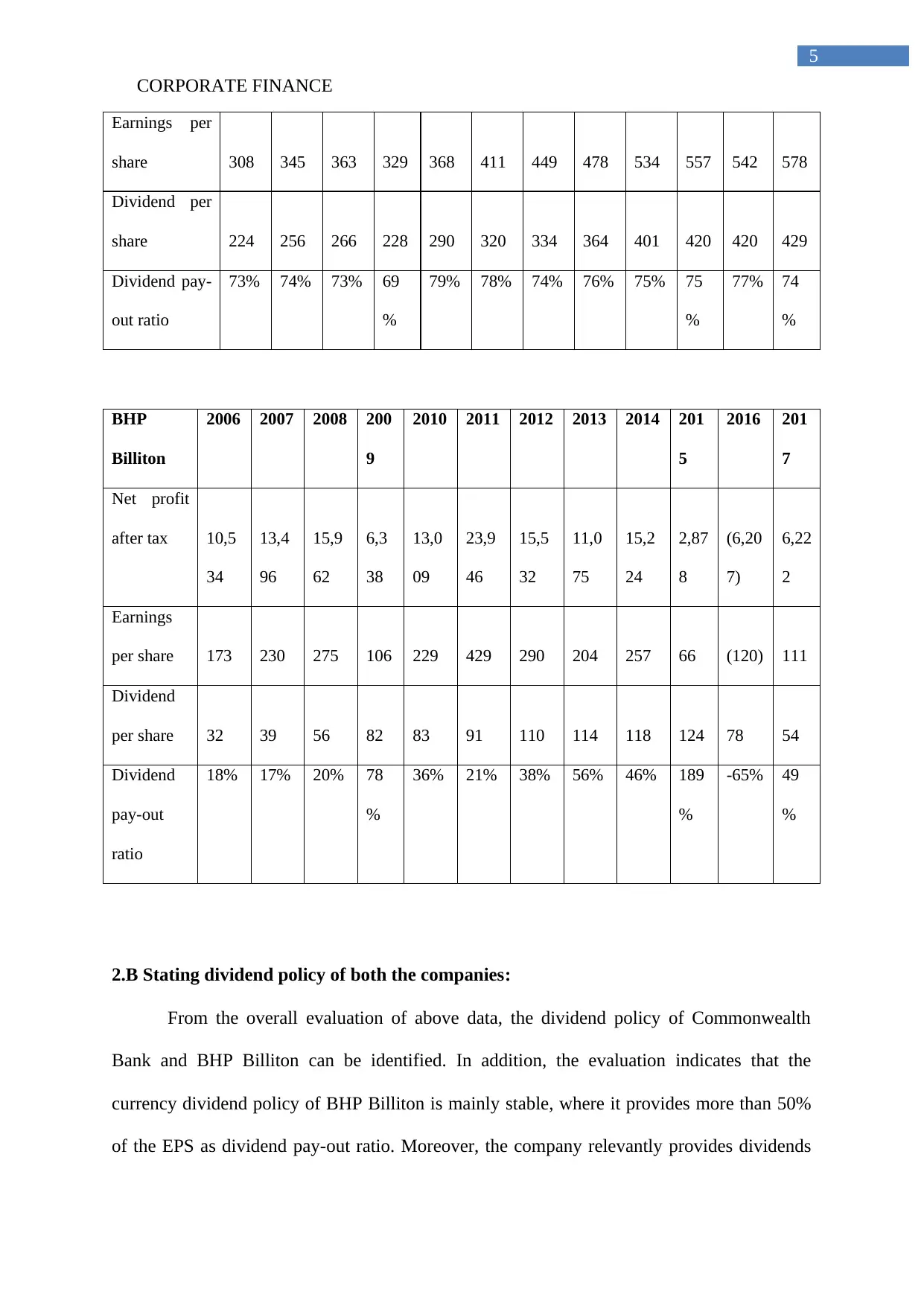
CORPORATE FINANCE
5
Earnings per
share 308 345 363 329 368 411 449 478 534 557 542 578
Dividend per
share 224 256 266 228 290 320 334 364 401 420 420 429
Dividend pay-
out ratio
73% 74% 73% 69
%
79% 78% 74% 76% 75% 75
%
77% 74
%
BHP
Billiton
2006 2007 2008 200
9
2010 2011 2012 2013 2014 201
5
2016 201
7
Net profit
after tax 10,5
34
13,4
96
15,9
62
6,3
38
13,0
09
23,9
46
15,5
32
11,0
75
15,2
24
2,87
8
(6,20
7)
6,22
2
Earnings
per share 173 230 275 106 229 429 290 204 257 66 (120) 111
Dividend
per share 32 39 56 82 83 91 110 114 118 124 78 54
Dividend
pay-out
ratio
18% 17% 20% 78
%
36% 21% 38% 56% 46% 189
%
-65% 49
%
2.B Stating dividend policy of both the companies:
From the overall evaluation of above data, the dividend policy of Commonwealth
Bank and BHP Billiton can be identified. In addition, the evaluation indicates that the
currency dividend policy of BHP Billiton is mainly stable, where it provides more than 50%
of the EPS as dividend pay-out ratio. Moreover, the company relevantly provides dividends
5
Earnings per
share 308 345 363 329 368 411 449 478 534 557 542 578
Dividend per
share 224 256 266 228 290 320 334 364 401 420 420 429
Dividend pay-
out ratio
73% 74% 73% 69
%
79% 78% 74% 76% 75% 75
%
77% 74
%
BHP
Billiton
2006 2007 2008 200
9
2010 2011 2012 2013 2014 201
5
2016 201
7
Net profit
after tax 10,5
34
13,4
96
15,9
62
6,3
38
13,0
09
23,9
46
15,5
32
11,0
75
15,2
24
2,87
8
(6,20
7)
6,22
2
Earnings
per share 173 230 275 106 229 429 290 204 257 66 (120) 111
Dividend
per share 32 39 56 82 83 91 110 114 118 124 78 54
Dividend
pay-out
ratio
18% 17% 20% 78
%
36% 21% 38% 56% 46% 189
%
-65% 49
%
2.B Stating dividend policy of both the companies:
From the overall evaluation of above data, the dividend policy of Commonwealth
Bank and BHP Billiton can be identified. In addition, the evaluation indicates that the
currency dividend policy of BHP Billiton is mainly stable, where it provides more than 50%
of the EPS as dividend pay-out ratio. Moreover, the company relevantly provides dividends
⊘ This is a preview!⊘
Do you want full access?
Subscribe today to unlock all pages.

Trusted by 1+ million students worldwide
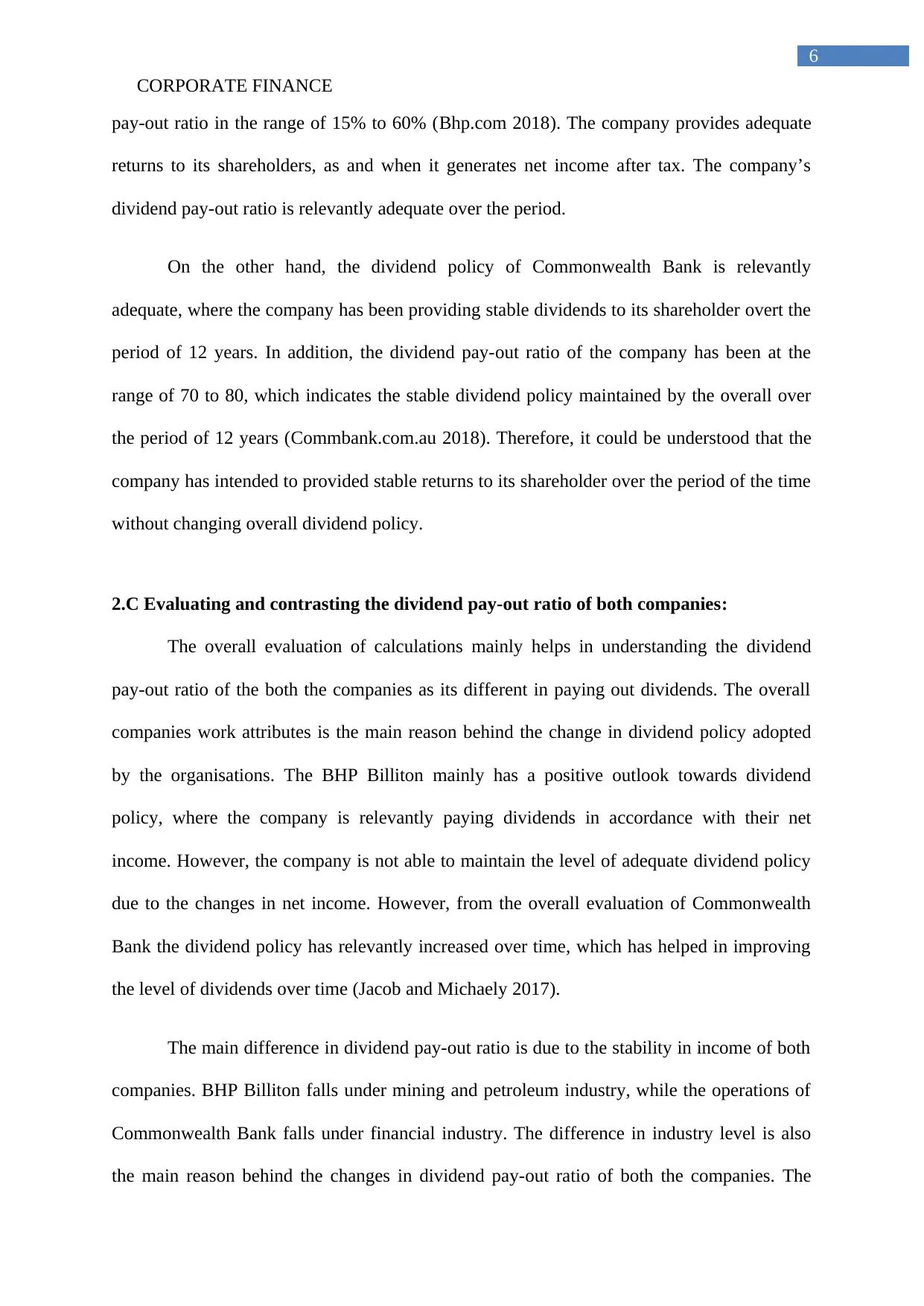
CORPORATE FINANCE
6
pay-out ratio in the range of 15% to 60% (Bhp.com 2018). The company provides adequate
returns to its shareholders, as and when it generates net income after tax. The company’s
dividend pay-out ratio is relevantly adequate over the period.
On the other hand, the dividend policy of Commonwealth Bank is relevantly
adequate, where the company has been providing stable dividends to its shareholder overt the
period of 12 years. In addition, the dividend pay-out ratio of the company has been at the
range of 70 to 80, which indicates the stable dividend policy maintained by the overall over
the period of 12 years (Commbank.com.au 2018). Therefore, it could be understood that the
company has intended to provided stable returns to its shareholder over the period of the time
without changing overall dividend policy.
2.C Evaluating and contrasting the dividend pay-out ratio of both companies:
The overall evaluation of calculations mainly helps in understanding the dividend
pay-out ratio of the both the companies as its different in paying out dividends. The overall
companies work attributes is the main reason behind the change in dividend policy adopted
by the organisations. The BHP Billiton mainly has a positive outlook towards dividend
policy, where the company is relevantly paying dividends in accordance with their net
income. However, the company is not able to maintain the level of adequate dividend policy
due to the changes in net income. However, from the overall evaluation of Commonwealth
Bank the dividend policy has relevantly increased over time, which has helped in improving
the level of dividends over time (Jacob and Michaely 2017).
The main difference in dividend pay-out ratio is due to the stability in income of both
companies. BHP Billiton falls under mining and petroleum industry, while the operations of
Commonwealth Bank falls under financial industry. The difference in industry level is also
the main reason behind the changes in dividend pay-out ratio of both the companies. The
6
pay-out ratio in the range of 15% to 60% (Bhp.com 2018). The company provides adequate
returns to its shareholders, as and when it generates net income after tax. The company’s
dividend pay-out ratio is relevantly adequate over the period.
On the other hand, the dividend policy of Commonwealth Bank is relevantly
adequate, where the company has been providing stable dividends to its shareholder overt the
period of 12 years. In addition, the dividend pay-out ratio of the company has been at the
range of 70 to 80, which indicates the stable dividend policy maintained by the overall over
the period of 12 years (Commbank.com.au 2018). Therefore, it could be understood that the
company has intended to provided stable returns to its shareholder over the period of the time
without changing overall dividend policy.
2.C Evaluating and contrasting the dividend pay-out ratio of both companies:
The overall evaluation of calculations mainly helps in understanding the dividend
pay-out ratio of the both the companies as its different in paying out dividends. The overall
companies work attributes is the main reason behind the change in dividend policy adopted
by the organisations. The BHP Billiton mainly has a positive outlook towards dividend
policy, where the company is relevantly paying dividends in accordance with their net
income. However, the company is not able to maintain the level of adequate dividend policy
due to the changes in net income. However, from the overall evaluation of Commonwealth
Bank the dividend policy has relevantly increased over time, which has helped in improving
the level of dividends over time (Jacob and Michaely 2017).
The main difference in dividend pay-out ratio is due to the stability in income of both
companies. BHP Billiton falls under mining and petroleum industry, while the operations of
Commonwealth Bank falls under financial industry. The difference in industry level is also
the main reason behind the changes in dividend pay-out ratio of both the companies. The
Paraphrase This Document
Need a fresh take? Get an instant paraphrase of this document with our AI Paraphraser
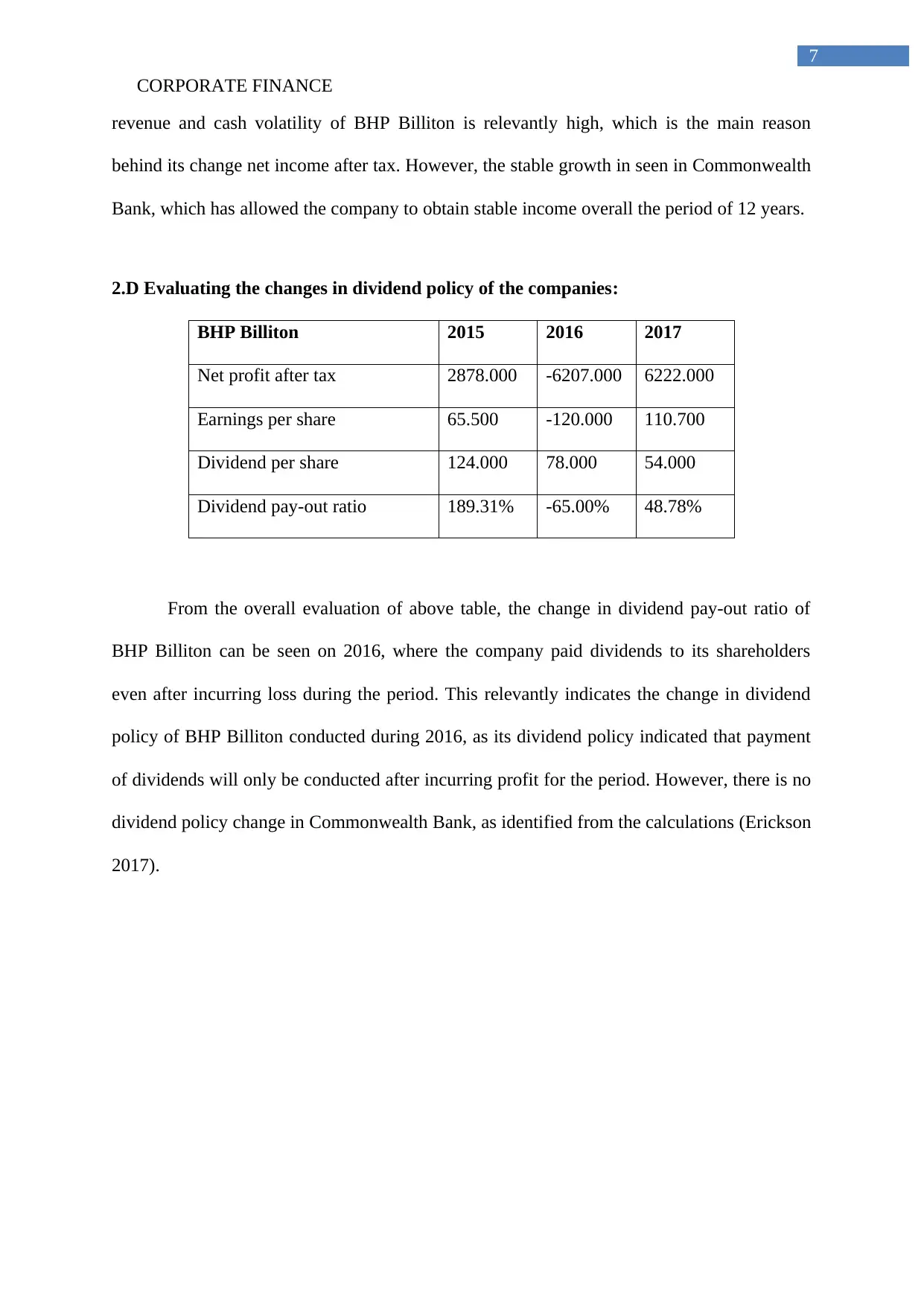
CORPORATE FINANCE
7
revenue and cash volatility of BHP Billiton is relevantly high, which is the main reason
behind its change net income after tax. However, the stable growth in seen in Commonwealth
Bank, which has allowed the company to obtain stable income overall the period of 12 years.
2.D Evaluating the changes in dividend policy of the companies:
BHP Billiton 2015 2016 2017
Net profit after tax 2878.000 -6207.000 6222.000
Earnings per share 65.500 -120.000 110.700
Dividend per share 124.000 78.000 54.000
Dividend pay-out ratio 189.31% -65.00% 48.78%
From the overall evaluation of above table, the change in dividend pay-out ratio of
BHP Billiton can be seen on 2016, where the company paid dividends to its shareholders
even after incurring loss during the period. This relevantly indicates the change in dividend
policy of BHP Billiton conducted during 2016, as its dividend policy indicated that payment
of dividends will only be conducted after incurring profit for the period. However, there is no
dividend policy change in Commonwealth Bank, as identified from the calculations (Erickson
2017).
7
revenue and cash volatility of BHP Billiton is relevantly high, which is the main reason
behind its change net income after tax. However, the stable growth in seen in Commonwealth
Bank, which has allowed the company to obtain stable income overall the period of 12 years.
2.D Evaluating the changes in dividend policy of the companies:
BHP Billiton 2015 2016 2017
Net profit after tax 2878.000 -6207.000 6222.000
Earnings per share 65.500 -120.000 110.700
Dividend per share 124.000 78.000 54.000
Dividend pay-out ratio 189.31% -65.00% 48.78%
From the overall evaluation of above table, the change in dividend pay-out ratio of
BHP Billiton can be seen on 2016, where the company paid dividends to its shareholders
even after incurring loss during the period. This relevantly indicates the change in dividend
policy of BHP Billiton conducted during 2016, as its dividend policy indicated that payment
of dividends will only be conducted after incurring profit for the period. However, there is no
dividend policy change in Commonwealth Bank, as identified from the calculations (Erickson
2017).
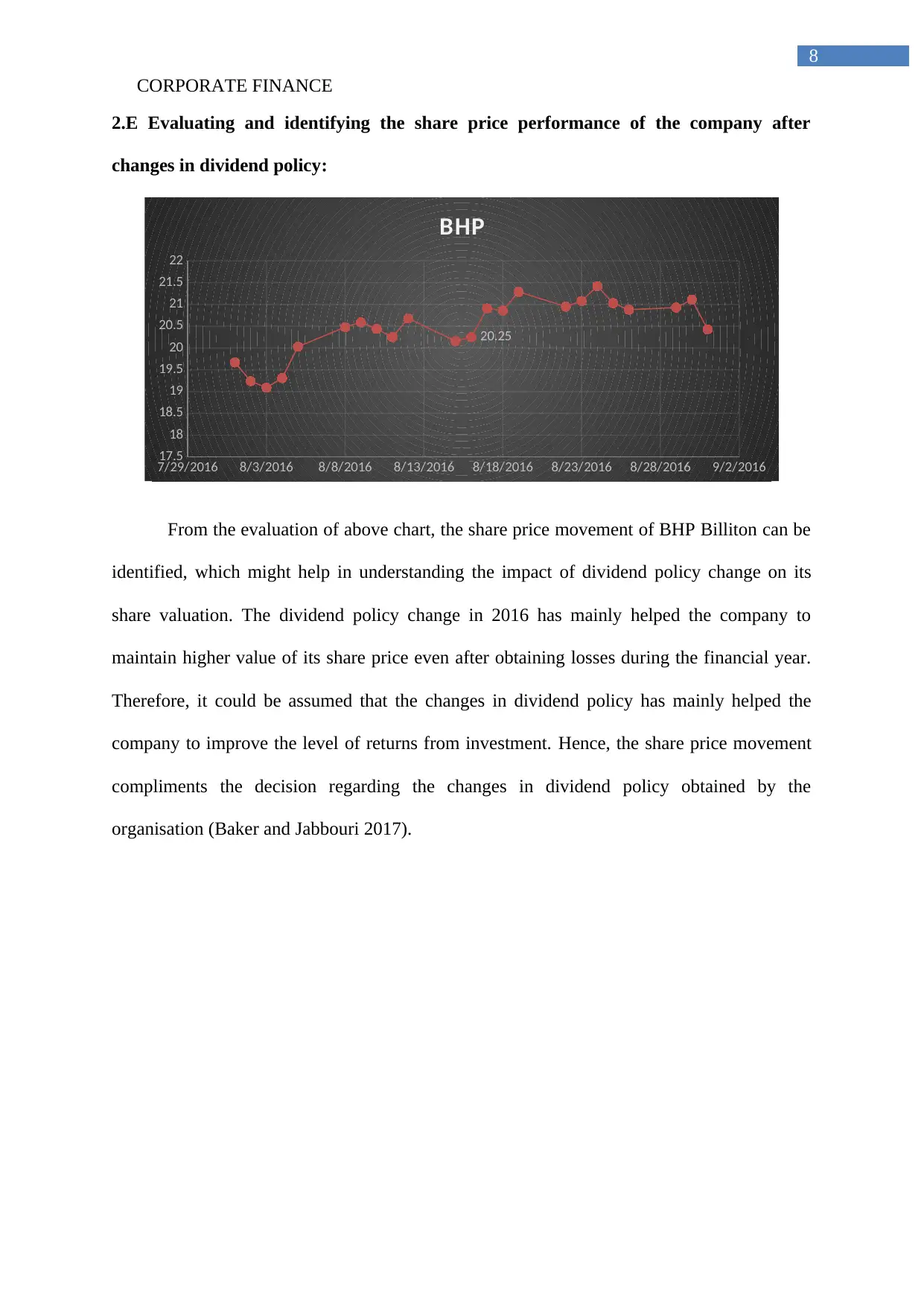
CORPORATE FINANCE
8
2.E Evaluating and identifying the share price performance of the company after
changes in dividend policy:
7/29/2016 8/3/2016 8/8/2016 8/13/2016 8/18/2016 8/23/2016 8/28/2016 9/2/2016
17.5
18
18.5
19
19.5
20
20.5
21
21.5
22
20.25
BHP
From the evaluation of above chart, the share price movement of BHP Billiton can be
identified, which might help in understanding the impact of dividend policy change on its
share valuation. The dividend policy change in 2016 has mainly helped the company to
maintain higher value of its share price even after obtaining losses during the financial year.
Therefore, it could be assumed that the changes in dividend policy has mainly helped the
company to improve the level of returns from investment. Hence, the share price movement
compliments the decision regarding the changes in dividend policy obtained by the
organisation (Baker and Jabbouri 2017).
8
2.E Evaluating and identifying the share price performance of the company after
changes in dividend policy:
7/29/2016 8/3/2016 8/8/2016 8/13/2016 8/18/2016 8/23/2016 8/28/2016 9/2/2016
17.5
18
18.5
19
19.5
20
20.5
21
21.5
22
20.25
BHP
From the evaluation of above chart, the share price movement of BHP Billiton can be
identified, which might help in understanding the impact of dividend policy change on its
share valuation. The dividend policy change in 2016 has mainly helped the company to
maintain higher value of its share price even after obtaining losses during the financial year.
Therefore, it could be assumed that the changes in dividend policy has mainly helped the
company to improve the level of returns from investment. Hence, the share price movement
compliments the decision regarding the changes in dividend policy obtained by the
organisation (Baker and Jabbouri 2017).
⊘ This is a preview!⊘
Do you want full access?
Subscribe today to unlock all pages.

Trusted by 1+ million students worldwide

CORPORATE FINANCE
9
Reference and Bibliography:
Baker, H.K. and Jabbouri, I., 2017. How Moroccan institutional investors view dividend
policy. Managerial Finance, 43(12), pp.1332-1347.
Bhp.com. (2018). [online] Available at:
https://www.bhp.com/-/media/documents/investors/annual-reports/2017/
bhpannualreport2017.pdf [Accessed 19 Apr. 2018].
Commbank.com.au. (2018). Shareholders – Financial information - 2004-2010 Annual
reports - Commonwealth Bank Group. [online] Available at:
https://www.commbank.com.au/about-us/shareholders/shareholder-information/2004-2010-
annual-reports.html [Accessed 19 Apr. 2018].
Erickson, M.J., 2017. The Relation Between Firm Dividend Policy and the Predictability of
Cash Effective Tax Rates.
Jacob, M. and Michaely, R., 2017. Taxation and dividend policy: The muting effect of
agency issues and shareholder conflicts. The Review of Financial Studies, 30(9), pp.3176-
3222.
Market Index. (2018). S&P/ASX 50 - Shares Prices & Charts. [online] Available at:
https://www.marketindex.com.au/asx50 [Accessed 19 Apr. 2018].
Novak, J., 2015. Systematic risk changes, negative realized excess returns and time-varying
CAPM beta. Finance a Uver, 65(2), p.167.
Ofori‐Sasu, D., Abor, J.Y. and Osei, A.K., 2017. Dividend policy and shareholders’ value:
evidence from listed companies in Ghana. African Development Review, 29(2), pp.293-304.
9
Reference and Bibliography:
Baker, H.K. and Jabbouri, I., 2017. How Moroccan institutional investors view dividend
policy. Managerial Finance, 43(12), pp.1332-1347.
Bhp.com. (2018). [online] Available at:
https://www.bhp.com/-/media/documents/investors/annual-reports/2017/
bhpannualreport2017.pdf [Accessed 19 Apr. 2018].
Commbank.com.au. (2018). Shareholders – Financial information - 2004-2010 Annual
reports - Commonwealth Bank Group. [online] Available at:
https://www.commbank.com.au/about-us/shareholders/shareholder-information/2004-2010-
annual-reports.html [Accessed 19 Apr. 2018].
Erickson, M.J., 2017. The Relation Between Firm Dividend Policy and the Predictability of
Cash Effective Tax Rates.
Jacob, M. and Michaely, R., 2017. Taxation and dividend policy: The muting effect of
agency issues and shareholder conflicts. The Review of Financial Studies, 30(9), pp.3176-
3222.
Market Index. (2018). S&P/ASX 50 - Shares Prices & Charts. [online] Available at:
https://www.marketindex.com.au/asx50 [Accessed 19 Apr. 2018].
Novak, J., 2015. Systematic risk changes, negative realized excess returns and time-varying
CAPM beta. Finance a Uver, 65(2), p.167.
Ofori‐Sasu, D., Abor, J.Y. and Osei, A.K., 2017. Dividend policy and shareholders’ value:
evidence from listed companies in Ghana. African Development Review, 29(2), pp.293-304.
1 out of 10
Your All-in-One AI-Powered Toolkit for Academic Success.
+13062052269
info@desklib.com
Available 24*7 on WhatsApp / Email
![[object Object]](/_next/static/media/star-bottom.7253800d.svg)
Unlock your academic potential
Copyright © 2020–2025 A2Z Services. All Rights Reserved. Developed and managed by ZUCOL.

